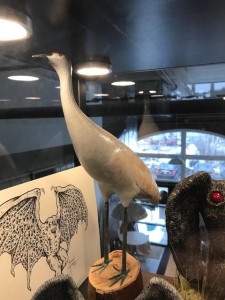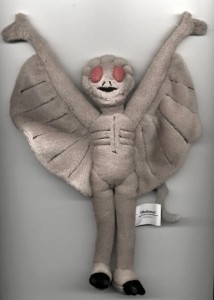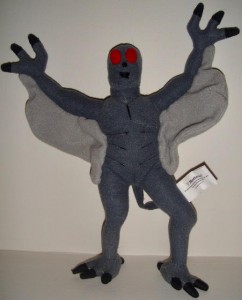
A new book, a new documentary, a new exhibit, a new death, a new fire top the 2018 news, in the midst of old disagreements about what Mothman looks like.
New Media

The appearance at the end of 2017 of a new documentary, Seth Breedlove’s The Mothman of Point Pleasant, and a new book, Mothman: Evil Incarnate by yours truly, caused the events of the winged weirdie to be at the forefront of 2018 thoughts about strange creatures.

Point Pleasant Fire


On July 1, 2018, Point Pleasant’s River Museum, which contains valuable exhibits related to the Silver Bridge and its collapse, was heavy damaged by a fire in the attic and second floor.

Several firefighters were sent to a local hospital for heat exhaustion due to the high temperatures encountered.
John Keel’s Death: Nine Years Later

Three days later marked nine years since John A. Keel’s death. John Alva Keel, 79, known for his UFO research and books, including The Mothman Prophecies, lived most of his life in New York City. He died July 3, 2009, at Mount Sinai Hospital in New York City, after some months in a nursing home near his Upper West Side apartment.
The site to follow for constant updates from Keel’s archives is Doug Skinner’s postings at John Keel: Not An Authority on Anything.
To find the best reprints of John A. Keel’s books, find them at Anomalist Books.
John Keel’s Brother Dies
Meanwhile, the Fortean world was learning that Keel’s brother had just died, in June 2018.
 Keel’s brother was born January 15, 1941 in Warsaw, New York and lived most of his life in the Burned Over Area of Upstate New York, as had the pre-adult Keel. The obituary stated it simply: “Raymond L. Kiley, 77 of Perry, passed away on Monday, June 4, 2018. He was born in Warsaw, to the late Chester (Irene Gibbs) Kiley. He is preceded in death by his brother, John Keel.
Keel’s brother was born January 15, 1941 in Warsaw, New York and lived most of his life in the Burned Over Area of Upstate New York, as had the pre-adult Keel. The obituary stated it simply: “Raymond L. Kiley, 77 of Perry, passed away on Monday, June 4, 2018. He was born in Warsaw, to the late Chester (Irene Gibbs) Kiley. He is preceded in death by his brother, John Keel.
“Ray enjoyed collecting sap, making maple syrup, fishing and cutting wood. He attended services at the First Congregational Church in Perry Center.”
New Mothman Exhibit


The International Cryptozoology Museum in Portland, Maine installed a new, expanded Mothman exhibit early in 2018.
Åke Franzén Investigations

Åke Franzén, October 22, 1977. Håkan Blomqvist photo.
Swedish ufologist Håkan Blomqvist informed me of the little known onsite Mothman investigations of Åke Franzén. Blomqvist writes on January 11, 2018:
In 1969 Swedish ufologist Åke Franzén (1936-1995) travelled to Point Pleasant, West Virginia and spent five weeks interviewing around 30 Mothman witnesses and visiting observation sites. But his trip proved to be more than just an ordinary field investigation as Åke fell deeply in love with the first Mothman witness Linda Scarberry. Because of this relationship, he got a unique personal insight in the events 1966-1967. Åke entertained plans to emigrate to the U.S. but he couldn´t find a job so this dream had to be abandoned. The many letters exchanged between Åke and Linda are now preserved at AFU but contain very little data on Mothman. They are essentially personal love letters. Åke Franzén was a close friend, a dedicated ufologist and an early AFU board member, 1980-1983.
On May 19, 1973, Håkan Blomqvist and Anders Liljegren interviewed Åke Franzén about his five weeks of investigations in Point Pleasant. Blomqvist says the interview is on his webpage, but unfortunately only in Swedish. We look forward to reading the English translation, someday.

Åke Franzén reads the 1975 Saturday Review Press edition first edition of The Mothman Prophecies (in 1978). Håkan Blomqvist photo.
Mothman: No Arms, No Head
Back in November 2006, I observed that the original descriptions of Mothman were being changed by re-interviewing eyewitnesses over and over again.
I wrote:
From what I have found, the eyewitnesses have changed their descriptions, down through the years, to fit the popular cultural concepts.
News articles and the earliest descriptive John A. Keel writings in FSR and Strange Creatures From Time and Space discuss a “large bird” – with the mention of “an angel,” used more in reference to the wings, not the body.
In Keel’s myth-making The Mothman Prophecies, the more human view of the creature begins to be reinforced.
By the time Scarberry and others are re-interviewed in the 21st century (especially since 2002), for books, documentaries, and news clips, the Mothman has become a fully humanized creature with a head, arms, and legs that were not there in the first reports.
These representations – Frazetta’s cover, that stature in Point Pleasant, “moths” in the movies – have all grown to be mirrors of myths based on the thoughts of insects, aliens, and authors. This creature has little or nothing to do with the real Mothman of 1966 – truly an avian mystery – now mostly seen through Keel’s demonological glasses. Unfortunately.
I followed this with a rebuttal by the Mothman Festival’s John Frick and my continued thoughts on this “debate,” on the 40th anniversary of the first Mothman events, in 2006.
I still feel the same way as when I wrote the following a dozen years ago:
As far as Linda Scarberry’s first accounts, yes, she talked about it being an angel, a big bird, and “wobbling.” In one description days afterwards, she said it “had muscular legs like a man.” But she also said she could not see “its head or arms. I don’t even know if the eyes are even in a head.”
Decades later, in new interviews in person and on television, Scarberry has described a head above shoulders, arms in addition to wings, and thin legs. I cannot help but think that her changes in descriptions reflect a popular cultural influence of what people began to “think” and “feel” about what Mothman should look like, versus what was originally seen and described.
***
Although I think John Frick has made his point, I still contend a sociological evolution occurred. The earlier more avian elements began to be discharged in favor of a more sinister “man-like” creature.
In 2018, in the era of Twitter and Facebook and more, the debate is ongoing. I posted the following graphics in social media to demonstrate my points, especially after I was made aware that Håkan Blomqvist inked a drawing of the eyewitnesses’ first description that exactly matches Gene Duplantier’s first Mothman drawing, based on the first eyewitnesses.
 Roger Scarberry’s original drawing, 1966. Notes by John A. Keel. (above & below)
Roger Scarberry’s original drawing, 1966. Notes by John A. Keel. (above & below)

###

John A. Keel’s Mothman File, using Gene Duplantier’s circa 1969 drawing of the Roger Scarberry sighting (above).

Closeup of Duplantier’s Mothman drawing, darkened and sepia enhanced (above and below).

###

Gene Duplantier’s drawing, edited with his permission for Loren Coleman’s slide presentations in the early 1970s. Added red-eyes and removed background. (above)

On Facebook on July 3, 2018, Swedish ufologist Håkan Blomqvist writes: “This is the drawing I made after interviewing Mothman investigator Åke Franzén in May 1973.”
It appeared on the cover of Ufologen, #12, November-December 1973. Comparing it to the earlier Gene Duplantier drawings from the late 1960s, it can be seen from the background that this sketch is a revised copy of Duplantier’s work. (above and below)

###

This is the “Mystery Museum 1 Mothman,” black color variation that is rare. This collection was produced by Medicom Toy, in Japan, but has been out of production since 2000. They were imported into the USA via Clawmark Toys. (above)
###

In 2001, I supervised the cover for my new book, Mothman and Other Curious Encounters, a book requested be finished by 2002 to tie into the Sony/Screen Gems film, The Mothman Prophecies. Wildlife artist Bill Rebsamen adapted the original eyewitnesses’ drawings and Gene Duplantier’s Mothman sketch to deliver an original piece of art. (above and two below)


Mothman and Other Curious Encounters
###
Meanwhile, Mothman items with hands, claws, and heads continue to pop up, especially in the 2000s. This is occurring despite the fact Mothman never appeared this way to any of the early witnesses.







The Mothman sculpture is iconic in Point Pleasant, and is a beautiful work of art. But it has everything to do with the name “Mothman” being freely interpreted as an insect for the creature – and nothing to do with what Mothman was said to look like.
The 1966-1967 Mothman was hardly a “moth.”


[...] on a lazy Sunday afternoon. Or why not someone with media chops like Loren Coleman? He has some Breaking Mothman News, Plus An Old Debate Continues on the appearance of West Virginia’s native entity. Hey, History Channel. Want someone [...]